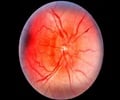The cause of geographic atrophy, a form of macular degeneration, has been identified by recent research at the University of Virginia School of Medicine.
- Geographic atrophy may be caused by the activation of an enzyme called cGAS.
- Geographic atrophy is a form of macular degeneration.
- Blocking the activation of cGAS may offer new treatment for age-related macular degeneration.
Ambati and Nagaraj Kerur, PhD, assistant professor in the Department of Ophthalmology, and their laboratories have determined that the culprit is an enzyme called cGAS. The enzyme plays an important role in the body's immune response to infections by detecting foreign DNA. But the molecule's newly identified role in the "dry" form of age-related macular degeneration comes as wholly unexpected.
The researchers noted that cGAS may be an alarm not just for pathogens but for other harmful problems that warrant responses from the immune system. The enzyme may also play important roles in conditions such as diabetes, lupus and obesity, and researchers already are working to create drugs that could inhibit its function. "Because the target we're talking about is an enzyme, we could develop small molecules that could block it," Kerur said. "There are many drugs already on the market that target specific enzymes, such as the statins [which are used to lower cholesterol levels.]"
Potential New Treatment for Macular Degeneration
The promising new lead comes as good news for researchers seeking to develop new treatments for dry macular degeneration, as clinical trials in recent years have come to dead end after dead end.
The UVA researchers expect the development of a drug to inhibit cGAS will take several years, and that drug would then need to go through extensive testing to determine its safety and effectiveness for combating macular degeneration.
The researchers also hope to develop a way to detect the levels of the enzyme in patients' eyes. That would let them determine when best to administer a treatment that blocks cGAS. "If they have high levels of this enzyme in their eye, they might be a wonderful candidate for this sort of treatment," Ambati said. "This is really precision medicine at the single-molecule level."
References:
- Nagaraj Kerur, Shinichi Fukuda, and Jayakrishna Ambati. cGAS Drives Noncanonical-Inflammasome Activation in Age-Related Macular Degeneration, Nature Medicine doi:10.1038/nm.4450










